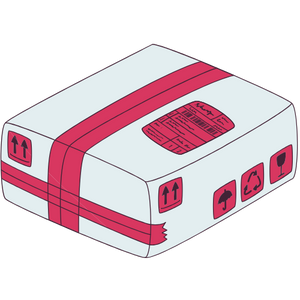Are my IUD and cup a good match?
Are there any contraindications to using a menstrual cup to collect your flow when you have a copper IUD or a hormonal IUD? Are cups and IUDs a good match? That’s a great question!
As more and more young women, teens, and adults move away from oral and hormonal contraception and opt for an IUD, it’s essential to know whether you can safely use a menstrual cup.
So, IUDs and menstrual cups: are they compatible? What do gynecologists and doctors say? If so, what precautions should you take? What are the proven risks? And what about the so-called suction effect? Myth or reality? Can a cup really suction out an IUD? Can a cup displace an IUD?
Today, Louloucup is focusing on a central and very important question regarding women’s intimacy.
Birth control and the cup: let’s break it down!
Let’s talk about birth control
Interested in birth control? Check out our in-depth article: Periods and Birth Control: The Impact on Your Menstrual Flow. We cover all available birth control methods and their real effects on menstruation.
Let’s talk about the cup
Are you curious about the menstrual cup, how to use it, which model to buy, or what size to choose?
Find valuable information in our complete menstrual cup guide and in our Louloucup Menstrual Cup User Manual.

What is an IUD?
The IUD is a very effective contraceptive method. The name can be confusing, but of course, an IUD does not make you sterile! Not at all. Just like the pill, patch, or implant, it’s simply a way to prevent unwanted pregnancies.
Known as an IUD, intrauterine device, or IUS, intrauterine system, the IUD comes in two very different versions:
- the copper IUD,
- and the hormonal IUS.
How does an IUD work?
In both cases, the IUD looks like a small plastic T.
With a copper IUD, the device is wrapped in a copper wire. With a hormonal IUD, it contains a dose of hormones. That’s it.
While copper blocks sperm, hormones affect the menstrual cycle. So, the two types of IUDs work in completely different ways. Still, they have the same goal: to prevent pregnancy.
How is an IUD inserted?
The IUD is inserted and placed in the uterine cavity. The procedure is very quick—less than fifteen minutes. It’s often recommended to take a painkiller beforehand. The process should not be painful. The woman may feel a slight, uncomfortable pinch and, most importantly, should feel reassured and guided throughout the insertion by the healthcare professional.
IUDs must be inserted by a healthcare professional trained in the procedure, such as a general practitioner, gynecologist, or midwife. The IUD is effective as soon as it’s in place. Copper IUDs can also be used for emergency contraception. Once inserted, an IUD can last for several years (between 2 and 10 years depending on the type). It can also be removed at any time if the patient wishes.
Two types of IUDs: copper and hormonal
Spotlight on the copper IUD (also called an IUC)
The copper in the IUD traps sperm. It contains no hormones, which is a major advantage for women who can’t tolerate them. It’s considered one of the best non-hormonal contraceptives.
However, the copper IUD can affect the length and intensity of your periods. Especially during the first cycles after insertion, periods can be very heavy, even hemorrhagic. They can also last longer, 7 to 10 days. For other women, the IUD is well tolerated and they notice little change.
A closer look at the hormonal IUD (also called SIU)
Unlike the copper IUD, the hormonal IUD contains a synthetic progestin hormone. This hormone thickens the cervical mucus (a glycoprotein secretion at the cervix), which blocks sperm from passing through.
If the copper IUD increases period flow, the hormonal IUD, on the other hand, decreases flow or may even stop periods altogether in the long term.
How do you remove an IUD?
The IUD can be removed in just a few seconds by a healthcare professional. The doctor, gynecologist, or midwife gently pulls on the strings to extract it. The pain is usually less than what is felt during IUD insertion.
A quick reminder: Not everyone can tolerate an IUD. It can be naturally expelled by your body, either because your system doesn't accept it, it was placed too low, the shape of your uterus isn't suitable, or simply due to uterine contractions. In general, this expulsion often occurs within the first three months after insertion.
One thing is certain, though: your cup will not cause your IUD to be expelled.
Using an IUD and a menstrual cup
Are menstrual cups and IUDs compatible? What are the exact risks? What recommendations should be followed?
Yes, the cup and the IUD are friends!
There are no contraindications as of now for wearing a menstrual cup with an IUD. However, at Louloucup, we always recommend getting approval from your doctor, midwife, or gynecologist before using one.
However, be aware of the risk of shifting
While the so-called "suction effect" (which is a myth) has no impact on an IUD, a recent medical review highlighted the risk of IUD displacement if the cup is removed too abruptly. This is the main risk: the possibility of the IUD moving.
Precautions to take before using a cup with an IUD
Avant the first use of your LoulouCup with an IUD, a few precautions can be taken to ensure the best possible experience:
- Adjust the length of your IUD threads. Ask the person who inserted your IUD to cut the threads short enough to avoid them getting caught between the vaginal wall and the rim of the cup.
- Wait three months after getting an IUD before using a menstrual cup. This period is when the IUD may naturally be expelled.
- Ask a gynecologist about the length of your cervix to know when to stop inserting your menstrual cup.
Best practices for removing your menstrual cup
Your cup is full and you want to remove, empty, and rinse it? No sudden or forceful movements—otherwise you risk dislodging your IUD!
- Take the time to position yourself properly and wash your hands.
- With your fingertips, touch the stem, then gently slide your index finger between the vaginal wall and the cup to break the seal.
- You can then gently remove your cup by pulling on the stem or pinching the base.
- Once removed, empty your cup and wash it thoroughly. You can then put it back in place.
To learn more...
Curious about using a menstrual cup? Check out our other blog posts dedicated to menstrual cups:
- Menstrual cup and toxic shock: what is the real risk?
- Menstrual cup risks
- Menstrual cups: the zero-waste alternative for your period
Loulou cups
Louloucup is a French brand offering cups and stylish, high-quality menstrual underwear to make life easier for women and teenagers during their periods.

Our Loulou cups are super soft and very easy to use
Our menstrual cups are made in France. Discover our full story! We offer two cup models: the classic Pink and the flexible Turquoise, each available in two sizes. Super affordable bundles let you purchase cups and underwear together for long-lasting hygienic protection that’s gentle on your body, day and night.




























